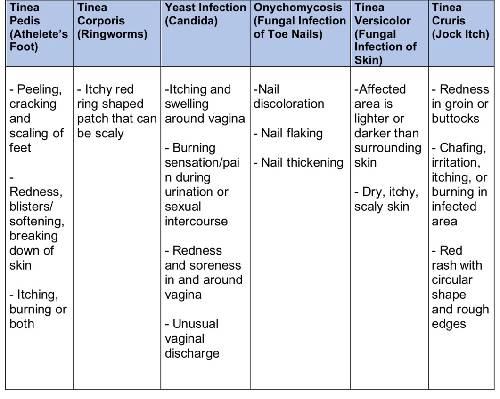
Contents
In this article we will look at:
- What is a fungal infection?
- How does fungal infection occur?
- Who is prone to fungal infection?
- What are the causes of fungal infection?
- What are the symptoms of fungal infection?
- How is fungal infection diagnosed?
- What is the treatment for fungal infection?
You can click on any of the links above to navigate to the section of your interest.
What is a fungal infection?
A fungus is a primitive organism and the fungi can live everywhere in the air, in the soil, on plants and in water. Some fungi are helpful, while others harmful.
Fungal infections, caused by harmful fungi are very common and are not very serious if they are diagnosed quickly and correctly and treated. However, where fungal infections are concerned, once treated, reinfections can easily occur, as fungi can be a tad difficult to kill.
How does fungal infection occur?
Because fungal spores are often present in the air or in the soil, one can inhale the spores or they can land on a person. Thus fungal infections often start off in the lungs or on the skin.
People with weak immune systems are very prone to fungal infections.
Examples of fungal infections include:
- tinea pedis (athlete's foot)
- tinea corporis (ringworms)
- yeast infection
- onychomycosis (fungal infection of the toenails)
- tinea versicolor (fungal infection of the skin)
- tinea cruris (jock itch)
Who is prone to fungal infection?
Those who are prone to fungal infections include:
- people with weakened immune systems such as children, elderly people, people suffering AIDS, HIV infection, cancer, diabetes
- people with a genetic predisposition toward fungal infections
- people who sweat a lot since sweaty clothes and shoes can enhance fungus growth on the skin
- people who come in contact with a person suffering from a fungal infection
- people who frequent communal areas with moisture, such as locker rooms and showers, since fungi require moisture to grow and reproduce
- people who are obese as they have excessive skin folds
What are the causes of fungal infection?
Common fungal skin infections are caused by yeasts (such as Candida or Malassezia furfur) or dermatophytes, such as Epidermophyton, Microsporum, and Trichophyton.
Fungal infection occurs when the fungal spores come into contact with the skin or are inhaled.
What are the symptoms of fungal infection? How is fungal infection diagnosed?
The symptoms of various kinds of fungal infections are as follows:

Diagnosis
For fungal infections, you can consult a general practitioner or a dermatologist. Doctors usually diagnose the infection by scraping scaling skin off of a person and inspecting it under a microscope for evidence of any fungus.
What is the treatment for fungal infection?
For fungal infection, the doctor will treat you based on the type and of fungal infection, you suffer from, and also the severity of the condition. He may prescribe topical anti-fungal medication and oral drugs. Most fungal skin infections can be treated with over-the-counter or prescription creams.
For severe cases however the doctor may require additional methods.
Patient Experiences



Questions answered by trusted doctors


Did you know?
An emerging epidemic of fungal infections
Dermatologists across India have warned of “an epidemic of fungal infections” that even the strongest antifungal creams are failing to treat.
Recurrent fungal skin infections
A host of fungal skin infections have turned recurrent, relapsing soon after the drug dosage is over.
Sale of topical steroids in India
The sale of topical steroids accounts for 82 per cent of the topical dermatology market.
Related videos
Related articles
Polyps are referred to as the abnormal tissue growths that usually appear as small, flat bumps or small versions of the mushroom stalks.
Breast cancer occurs when healthy cells of breast tissue change and may begin to grow out of control which can appear as a lump within breast tissue. Breast Cancer Treatment includes chemotherapy, radiotherapy,surgery depend on the type of cancer.
A surgical procedure in which either total or partial part of hip is replaced with artificial prosthesis is called as Hip Replacement.


